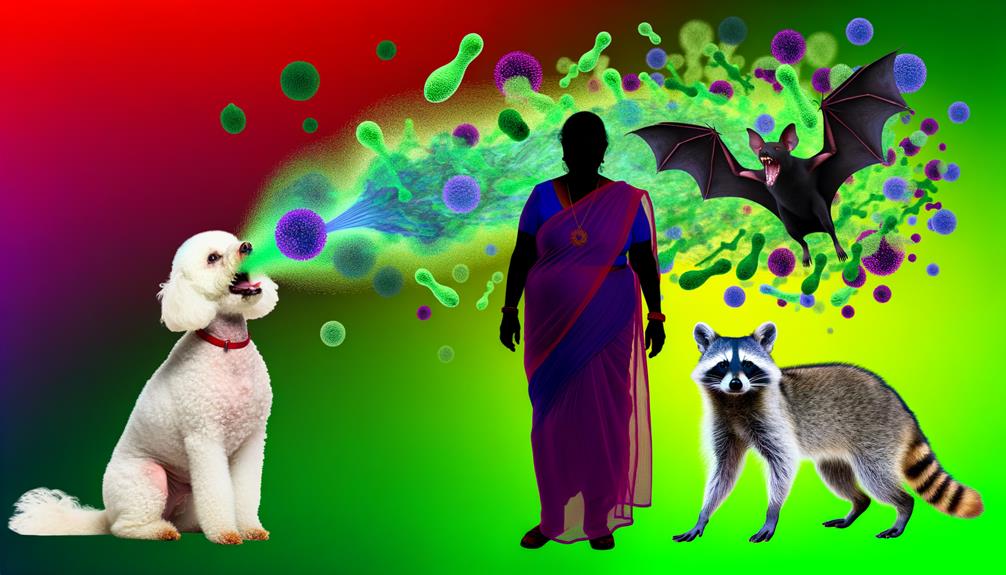How Do Dogs Bats and Raccoons Transmit Disease to Humans?
Dogs, bats, and raccoons transmit diseases to humans via several routes. Canine diseases, such as rabies and leptospirosis, are often spread through infected saliva, urine, or through contact with contaminated soil.
Bats serve as reservoirs for Ebola, Marburg, Nipah, and coronaviruses, transmitting these through exposure to their fluids or via intermediary hosts. Raccoons, on account of their opportunistic feeding habits, harbor various pathogens and disseminate diseases like rabies and Leptospirosis.
An understanding of these transmission mechanisms sets a foundation for developing effective prevention strategies, the exploration of which provides critical insights.

Key Takeaways
- Dogs can transmit diseases like rabies and leptospirosis through bites, scratches, or contact with their urine.
- Bats, being natural reservoirs for viruses like Ebola and coronaviruses, can transmit diseases through direct contact with their saliva, urine, or feces.
- Bats can also transmit diseases to humans through intermediary hosts like livestock.
- Raccoons can transmit diseases such as rabies, leptospirosis, and Baylisascaris procyonis, often through contact with their feces or contaminated environments.
- Preventive measures against such transmissions include good hygiene practices, safe animal handling, proper waste disposal, and regular veterinary care for pets.
Understanding Zoonotic Diseases
In the intricate web of life, zoonotic diseases represent a critical intersection where animal and human health converge, necessitating a thorough understanding of their mechanisms of transmission, potential impacts, and methods of control.
These diseases, transferred from animals to humans, stem from diverse agents including bacteria, viruses, and parasites. Each agent possesses unique characteristics, determining its transmission method, whether through direct contact, vector-borne pathways, or environmental exposure.
The impacts vary, causing mild to severe illnesses, or in worst cases, death. Control methods, thus, must be adaptive, incorporating preventive and responsive strategies. For instance, maintaining hygiene, vaccination, and early detection are preventive, while isolation and treatment respond to disease outbreaks.
Understanding zoonotic diseases, hence, demands a multidisciplinary approach, aligning human, animal, and environmental health.
Disease Transmission From Dogs
As we shift our focus to the transmission of diseases from dogs to humans, it is paramount to highlight three diseases of major concern: Canine Rabies, Leptospirosis, and Hookworm Infections.
Each of these diseases presents unique transmission pathways and health implications, necessitating thorough examination and understanding.
The ensuing discussion will elucidate the mechanisms of transmission, the prevalence of these diseases, and the potential health impact on the human population.
Canine Rabies Transmission
Understanding the transmission of rabies from dogs to humans necessitates a detailed examination of the canine's behavior, the nature of the virus, and the specific conditions that facilitate its spread.
The rabies virus is primarily spread through the saliva of an infected dog, often through a bite or scratch. Canine behavior such as increased aggression or unusual friendliness can indicate a rabid dog. The virus incubates in the body, eventually reaching the brain and salivary glands. Transmission to humans usually occurs when infected saliva enters a break in the skin.
Risk factors include inadequate vaccination, proximity to stray dogs, and lack of post-exposure prophylaxis. Therefore, careful observation of canine behavior and prompt medical attention can greatly reduce the risk of transmission.
Leptospirosis From Dogs
Shifting focus to Leptospirosis, this bacterial disease, often transmitted from dogs to humans, presents a unique set of transmission dynamics and risk factors. Infected canines shed Leptospira bacteria in their urine, and humans are susceptible to infection through direct or indirect contact with this contaminated urine. The bacteria can enter the human body through skin wounds or via mucous membranes of the eyes, nose, and mouth.
Floodwater and moist soil are conducive environments for leptospires. Certain activities increase human exposure to the bacteria, these include recreational water sports, gardening, and occupations like farming, veterinary medicine, and sewer maintenance. Effective prevention measures involve maintaining good hygiene, use of personal protective equipment, and ensuring pets are regularly vaccinated.
Hookworm Infections in Humans
While leptospirosis presents its own unique transmission dynamics, another zoonotic disease, hookworm infection, is also noticeably transmitted from dogs to humans, warranting an in-depth analysis of its epidemiology.
Canines, as primary hosts of Ancylostoma caninum, excrete hookworm larvae in their feces. When humans come into contact with contaminated soil, larvae penetrate the skin causing cutaneous larva migrans, or 'creeping eruption'. This zoonosis is particularly prevalent in areas with poor sanitation or where dogs are frequently dewormed.
Upon infection, patients experience pruritic, serpiginous erythematous tracks on the skin, indicative of larval migration. To prevent transmission, pet owners must maintain hygiene, employ regular deworming schedules, and avoid direct skin contact with potentially contaminated soils.
Bats and Their Infectious Diseases
Bats, known reservoirs of numerous zoonotic viruses, present a critical aspect of the discourse on animal to human disease transmission. By examining the extent of bat-borne viral diseases and their respective transmission mechanisms, we can gain a thorough understanding of the potential health risks associated with these nocturnal creatures.
Additionally, we must consider strategies for preventing bat-related infections, thereby reducing the zoonotic disease burden on human populations.
Bat-Borne Viral Diseases
A significant number of viral diseases, some with severe implications for human health, are known to originate from bats. These winged mammals are natural reservoirs for a plethora of zoonotic viruses, including Ebola, Marburg, and Nipah, which possess high pathogenic potential. They also host the rabies virus and coronaviruses, the latter being responsible for the outbreaks of Severe Acute Respiratory Syndrome (SARS), Middle East Respiratory Syndrome (MERS), and most recently, COVID-19.
Strikingly, bats harbor these viruses without exhibiting symptoms, owing to their unique immune system. Understanding this complex viral-host interaction can aid in predicting disease emergence and devising strategies to counter future outbreaks, ensuring humans' freedom from such devastating diseases.
Transmission Mechanisms in Bats
Despite the unique ability of bats to harbor a multitude of zoonotic viruses without showing symptoms, it is the mechanisms of how these diseases are transmitted from bats to humans that pose a challenging dilemma to scientists and researchers.
Bats transmit diseases through several means, most noticeably through direct contact with their saliva, urine, feces, or blood, often during a bite or scratch. Viral shedding in the environment, particularly in bat roosts, serves as another route of transmission.
Importantly, intermediary hosts such as livestock or pets may be infected first before passing the disease to humans. Understanding these mechanisms is crucial to both public health and the preservation of bat populations, which play essential roles in ecosystems.
Preventing Bat-Related Infections
To mitigate the risk of bat-related infections, it's essential to explore strategies that encompass both human behavior modification and habitat management, thereby reducing potential exposure to bat-borne viruses. One effective method necessitates the avoidance of direct bat contact, as this may lead to the transmission of rabies or other infectious diseases.
Individuals should be educated on the risks associated with handling bats, even in a domestic setting. Habitat management is equally vital, with strategies involving the careful control of bat populations in urban settings. For instance, utilizing bat houses to concentrate bat populations away from human dwellings can be beneficial.
Additionally, the surveillance and vaccination of bats, where feasible, could further reduce the transmission risk. Collectively, these measures can help maintain the delicate balance between human freedom and public health.
Raccoons: Carriers of Pathogens
Raccoons, often found rummaging in urban trash bins, are known carriers of numerous pathogens, representing a significant risk for zoonotic disease transmission to humans. As opportunistic feeders, raccoons are particularly prone to pick up a variety of bacteria, parasites, and viruses, some of which can be passed to humans.
Raccoons are capable of hosting:
- *Leptospirosis*: A bacterial disease that can be contracted through contact with raccoon urine.
- *Baylisascaris procyonis*: A roundworm infection that can be severe in humans.
- *Rabies*: A viral disease that raccoons are major reservoirs for in certain geographic areas.
- *Giardiasis*: A parasitic infection that can be contracted through contact with raccoon feces.
Understanding the role raccoons play in disease transmission is critical for public health strategies.
Common Diseases Transmitted
In the interface of human-animal interaction, several zoonotic diseases stand out due to their frequency of transmission and potential to cause serious illness.
Dogs, for instance, can transmit rabies, a fatal viral disease, and leptospirosis, a bacterial disease causing a wide array of symptoms.
Bats are known carriers of rabies as well, but they can also transmit coronaviruses, including the strain responsible for the COVID-19 pandemic.
Raccoons pose a risk of transmitting rabies, along with other serious diseases such as leptospirosis and raccoon roundworm, an intestinal parasite that can cause severe neurological problems.
Prevention and Protection Measures
Given the potential risks associated with zoonotic diseases, it is crucial to devise thorough prevention and protection measures to minimize the likelihood of transmission from animals to humans.
Crucial steps include:
- *Hygiene Practices*: Regular hand washing, particularly after contact with animals, can greatly reduce the risk of disease transmission.
- *Safe Handling of Animals*: Handle animals, especially wild ones, with care to avoid exposure to potential disease vectors.
- *Proper Disposal of Animal Waste*: Animal feces can carry a range of pathogens, so it's vital to dispose of it correctly.
- *Vaccination*: Make sure that pets are up-to-date with their vaccinations, which can prevent the spread of diseases to humans.
These measures are not just necessary for individual protection but also for maintaining public health.
Importance of Veterinary Care
While hygiene practices and safe animal handling are crucial in preventing zoonotic diseases, seeking regular veterinary care for pets also plays a significant part in this preventive approach. Veterinary professionals are equipped to screen for pathogens and other health risks, thereby intercepting the transmission of diseases to humans.
They also administer essential vaccinations that reduce the likelihood of zoonotic disease spread. Veterinary care is not just a matter of animal wellness but a public health concern. Neglecting veterinary care can lead to increased vulnerability to infections and disease transmission.
Thus, proactive and regular visits to the veterinarian are essential to mitigating the health risks associated with pet ownership, safeguarding both animal and human health.
Conclusion
To conclude, dogs, bats, and raccoons can transmit various zoonotic diseases to humans, which necessitates strategic preventive measures.
The significance of veterinary care in maintaining the health of these animals is evident, as it can thwart the spread of pathogens.
Comprehending the transmission mechanisms of these diseases is pivotal in developing robust public health strategies, thereby safeguarding human health from zoonotic disease outbreaks.






